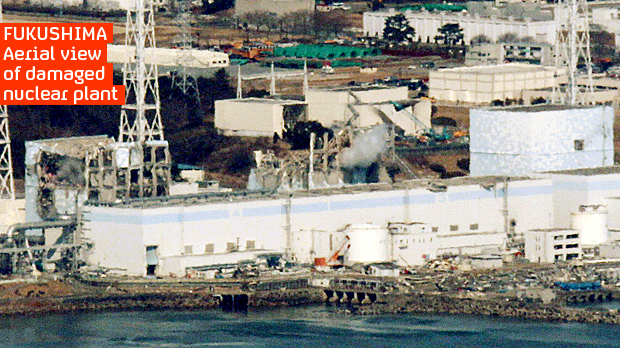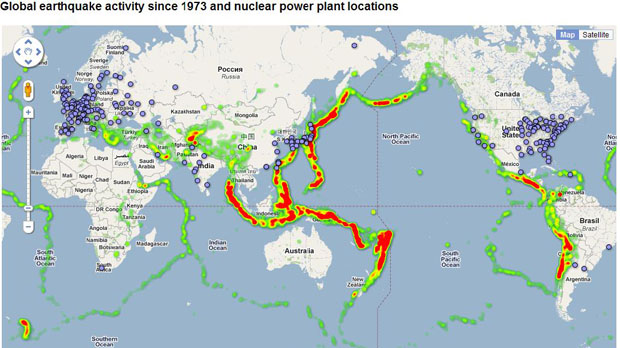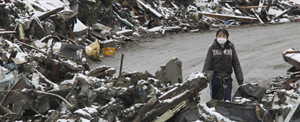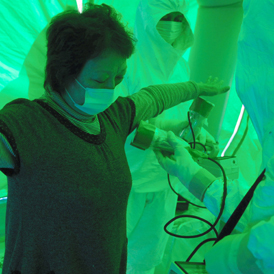Japan live blog: the battle to avoid nuclear meltdown
Latest updates, pictures and video from Japan as earthquake and tsunami recovery efforts are hampered by an escalating nuclear crisis.

Thursday 17 March
14.00 A nuclear expert tells Channel 4 News elements of the response to the nuclear crisis at Fukushima have been “shambolic” – but he expects a solution to be found.
The Chief Scientific Officer Sir John Beddington, has tried to calm fears of health risks. He says there is “absolutely no issue” for human health even in the worst case scenario of a meltdown.
Plus, see below for new aerial pictures show the damage at Fukushima’s reactors Nos 1 to 4.

12.30 Countries are stepping up radiation testing on their returning citizens – places including Malaysia and South Korea are testing returning nationals as they arrive back in the country.
10.00 As workers battle to cool the Fukushima nuclear plant in Japan, alarm spreads globally.
The US and the UK Governments have both said they will charter planes to get their citizens out.
06.30 International alarm over Japan’s nuclear crisis spreads. The US warns that radiation levels could be so high near the plant that recovery efforts may prove impossible, and the UK urges its citizens to leave Japan.
The EU’s energy chief, Guenther Oetinger, told the European parliament: “We are somewhere between a disaster and a major disaster. There could be further catastrophic events, which could pose a threat to the lives of people on the island…There is talk of an apocalypse and I think the word is particularly well chosen.”
Read more in the Channel 4 News Special Report on Japan
Wednesday 16 March
23.00 Jon Snow, on his way to Tokyo’s Nareda airport sent this update from the growing scenes of panic in the Japanese capital:
“I am aboard the Tokyo to Nareda airport bus on the freeway running West out of the city. It is very clogged. It’s a brittle sunny morning here gently warming from the freezing night.
“Hard to get ones mind round the threat as now described by the US regulatory authorities. Yet from what we do know here the US analysis does sound right.
“The facts they lay out are consistent, which is why so many believe the Japanese government is under playing it.
“It’s taken 30 mins to go two miles have I left enough time to get my flight?”
20.00 Channel 4 News Tom Clarke considers the far greater risk to human life if it transpires that nuclear fuel within the Fukushima plant has undergone fission.
19.30 UK Foreign Office change their advise to citizens in Japan and now recommend that all Brits leave the country
19.00 Alex Thomson: The ruins of Kamaishi

18.00 After his moving film from Ofunato last night, revealing the devastation unfurling before him as he travels through tsunami hit Japan, Alex Thomson reports on Channel 4 News tonight on yet another silent killer that could claim yet more lives; the icy wind, temperatures and snow that are taking grip in a land where hundreds of thousands of people have had their homes destroyed.
17.45 Dr Richard Wakeford of Britain’s University of Manchester has raised fears that the nuclear problems in Japan may not be the major health concern as cold weather sets in: “People are getting so concerned about what are at the moment pretty low levels of radiation as far as the general public is concerned. But the real problems … are in dealing with the earthquake and the tsunami,”
“If this was a developing country, we’d have people going down in their hundreds and thousands with the likes of typhoid and cholera by now. The questions should be: Where is the sewage going? What is the state of the drinking water? If I were a public health official, that would be my principle concern.”
17.30 U.S. says any U.S citizens living within 80km of Fukushima nuclear plant should evacuate or stay indoors.
U.S. Embassy in Tokyo: “We are recommending, as a precaution, that American citizens who live within 50 miles (80 km) of the Fukushima Nuclear Power Plant evacuate the area or to take shelter indoors if safe evacuation is not practical,”
17.20 Hillary Clinton raises questions about the use of nuclear energy in the U.S. after an interview with MSNBC
“What’s happening in Japan raises questions about the costs and the risks associated with nuclear power, but we have to answer those. We get 20 percent of our energy right now in the United States from nuclear power.”
17.00 Map released by using information from the United States Geological Survey (USGS) and the International Atomic Energy Agency (IAEA) reveals how the volatile earthquake zone is located near a number of nuclear power plants. Red spots indicate increased magnitude of quakes and the map displays areas of seismic shocks with 4.5+ magnitude since 1973.
16.45 Now is not the time to say whether developments at the Fukushima nuclear reactor have spiralled “out of control”, the UN atomic watchdog says. The European Union’s energy chief said earlier that Japanese authorities appeared to have lost control of the situation.
16.00 Reuters: Andriy Chudinov who worked to bring the Chernobyl disaster under control in 1986: “These are good guys. After all, they have had it even worse than we did. They had a tsunami first and now there are several reactors with problems. That’s a nightmare for any atomic worker.”
16.00 US forces in Japan are not allowed within 50 miles (80 km) of Japan’s crippled nuclear power plant, the Pentagon says. The measures are designed to keep US troops safe during a relief operation.
15.00 Japanese authorities report concerns about condition of spent nuclear fuel pool at Fukushima nuclear plant, units 3 & 4 – International Atomic Energy Agency (IAEA).
13.25 Workers battling the nuclear crisis in Fukushima are probably in a state of “pretty serious panic” and could make mistakes as technological failures feed them wrong information, nuclear expert Walt Patterson tells Channel 4 News.
Mike Granatt, an authority on risk management, tells Channel 4 News it’s important the authorities tell the public the full truth about what’s happening in the reactor – even if they aren’t quite sure of it themselves.
Comment via Facebook - Ali Powers: Nothing is inherently danger free but there is a spectrum of risk that outweighs the benefits. We need to start realising the danger we face when we pass these technologies on to successive generations.
“It’s important to tell people when they are in danger – but also when they are not. I think in Japan they know what they are supposed to do but they are in the worst of all situations, they’ve had so many disasters, and now they do not know what is going on inside the reactor – what they have to do is make an intelligent guess and follow the procedures.”
Read more on Japan: workers battle ‘out of control’ nuclear crisis
@jonsnowC4 tweets: The Japan Govt seems to have very little detail on Fukushima crisis..and even less on the other plant there and two more reported at risk.
13.10 British Embassy in Tokyo to provide coaches to help Britons leave Sendai, says Foreign Office. If you wish to travel on this bus, please register by contacting our consular team at the British Embassy in Tokyo on (+81) 80 3250 2924 or (+81) 35 211 1356 if calling from the UK, or 080 3250 2924 or 035 211 1356 if calling within Japan.
13.00 Japan nuclear safety agency says radiation levels outside Daiichi plant spiked about noon but fell back.

Click here for latest Japan picture gallery as blizzards sweep through tsunami-ravaged towns along Japan's north eastern coast.

(A woman is screened for possible radiation exposure at a public welfare centre in Hitachi.)
12.15 David Cameron tells MPs “everyone watching the dreadful events in Japan will want to learn nuclear lessons” during Prime Minister’s Questions.
11.15 The Japanese Red Cross says Tokyo is safe for international travellers “as far as nuclear radiation is concerned”.
10.50 French President Nicolas Sarkozy says he will call a special meeting of Group of 20 ministers to discuss options in the energy sector following nuclear crisis in Japan.
10.00 France says Japan has “lost control” of the situation at Fukushima nuclear plant.
Japan crisis VIDEO: Channel 4 News on YouTube
Industry Minister Eric Besson said: “Let’s not beat about the bush. They have visibly lost the essential of control (of the situation). That is our analysis, in any case, it’s not what they are saying,” Mr Besson told BFM television.
France urged its citizens to leave or move south of Tokyo.
09.00 The World Health Organisation’s representative in China says there is no evidence of any significant international spread of radiation from Japan’s crippled nuclear site.
08.21 Australia upgrades its travel warning for Japan, with Foreign Minister Kevin Rudd urging its citizens with non-essential roles in Japan to consider leaving Tokyo and the eight prefectures most damaged by the country’s earthquake and tsunami.
08.00 Channel 4 News Presenter Jon Snow reflects on five days in Japan, where he has seen unimaginable human loss – and the danger of the unseen nuclear threat.
Comment via Facebook - Diane Anderson: Hope is the belief in a positive outcome.
06.30 Smoke is seen rising from the Fukushima nuclear plant overnight and workers are temporarily evacuated as radiation levels spike within the facility.
People in the evacuation zone – around 140,000 – are ordered to remain indoors. Up to 180,000 have already left the area.
Workers across Japan are also continuing the heartbreaking recovery effort from Friday’s tsunami and earthquake.